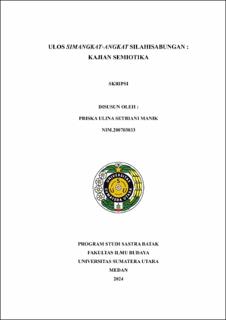| dc.contributor.advisor | Purba, Asriaty R. | |
| dc.contributor.advisor | Sinulingga, Jekmen | |
| dc.contributor.author | Manik, Priska Ulina Setriani | |
| dc.date.accessioned | 2024-10-23T04:54:18Z | |
| dc.date.available | 2024-10-23T04:54:18Z | |
| dc.date.issued | 2024 | |
| dc.identifier.uri | https://repositori.usu.ac.id/handle/123456789/98326 | |
| dc.description.abstract | This thesis is entitled Ulos Simangkat angkat Silahisabungan: Semiotic Study. Ulos Simangkat angkat is one of the ulos of Silahisabungan. This ulos, which comes from Silahisabungan, has a motif that is combined with the ulos motif of the Toba Batak ethnic group. This research aims to describe the form of motifs, motif functions and meanings found in Ulos Simangkat angkat. The theory used in this research is the semiotic theory put forward by Charles Sanders Peirce. The method used is descriptive qualitative. The research results show that the shape of Ulos Simangkat angkat is rectangular with a length of 250 centimeters and a width of 80 centimeters with the basic color usually being black. This black color is often decorated with red and white motifs, and sometimes gold or silver thread is used to add to its beauty and symbolic value. The functions found in Ulos Simangkat angkat are: (1) the function as a symbol of social status, such as indicating a person's status, position and power in Batak customs. (2) the function is used as a gift in traditional ceremonies to signify respect, appreciation and closeness between families. (3) protection and welfare function which functions as a protector and bringer of good luck in Batak tradition. (4) The function is used to pay respect to elders (5) the function is to strengthen cultural identity. The meanings contained in Ulos Simangkat angkat are: (1) based on the color which symbolizes strength, steadfastness and firmness. In the Batak traditional context, this color can symbolize sacredness and respect for ancestors. (2) based on motifs, having motifs consisting of vertical dotted lines which have meaning related to clan (marga) identity and social status in Batak society and are used to show family and historical relationships. | en_US |
| dc.language.iso | id | en_US |
| dc.publisher | Universitas Sumatera Utara | en_US |
| dc.subject | Ulos Simangkat angkat Silahisabungan | en_US |
| dc.subject | Motif | en_US |
| dc.subject | semiotics | en_US |
| dc.subject | SDGs | en_US |
| dc.title | Ulos Simangkat-Angkat Silahisabungan : Kajian Semiotika | en_US |
| dc.title.alternative | Ulos Simangkat-Angkat Silahisabungan: Semiotic Study | en_US |
| dc.type | Thesis | en_US |
| dc.identifier.nim | NIM200703033 | |
| dc.identifier.nidn | NIDN0022116205 | |
| dc.identifier.nidn | NIDN0026066206 | |
| dc.identifier.kodeprodi | KODEPRODI79211#Sastra Batak | |
| dc.description.pages | 101 Pages | en_US |
| dc.description.type | Skripsi Sarjana | en_US |
| dc.subject.sdgs | SDGs 4. Quality Education | en_US |


